Abstract
Penetration of liquid by passive impregnation method for Douglas-fir (Pseudotsuga menziesii Franco), sugi (Cryptomeria japonica D. Don) and Japanese larch (Larix leptolepis Gordon) was studied. Effects of initial moisture content of sugi (16, 43 and 70% moisture content) on liquid penetration were also studied. Dried Douglas-fir (mc=14%) and sugi (mc=16%), and green Japanese larch (mc=45%) and sugi (mc=70%) were treated by passive impregnation method for penetration analysis. It was observed that dried sugi had the highest level of liquid penetration both in length (170 mm) and width (8 mm) for all measured sections followed by green sugi, green Japanese larch and dried Douglas-fir. In case of different initial moisture content, the highest absorption (624 kg/m3) and penetration (maximum 87 and 96% at cross and longitudinal surfaces, respectively) was observed for sugi having the lowest initial moisture content under the same passive impregnation conditions. Absorption and penetration decreased with the increase of initial moisture content for sugi. These results could help in designing incising pattern and density, as well as solving the problems related to high initial moisture content of wood for passive impregnation.
Zusammenfassung
Untersucht wurde die Eindringung von Flüssigkeit in Douglasien- (Pseudotsuga menziesii Franco), Sugi- (Cryptomeria japonica D. Don) und japanischem Lärchenholz (Larix leptolepis Gordon) bei der Tauchimprägnierung nach vorheriger Dampfbehandlung. Darüber hinaus wurde an Sugiholz der Einfluss der Holzfeuchte (16, 43 und 70% Holzfeuchte) auf die Eindringung von Flüssigkeit untersucht. Für die Untersuchung der Eindringung wurde getrocknetes Douglasienholz (u=14%) und Sugiholz (u=16%) sowie frisches japanisches Lärchenholz (u=45%) und Sugiholz (u=70%) imprägniert. Es zeigte sich, dass trockenes Sugiholz sowohl in axialer Richtung (170 mm) als auch in radialer Richtung (8 mm) an allen Messstellen die größte Einbringmenge aufwies, gefolgt von frischem Sugiholz, frischem japanischem Lärchenholz und trockenem Douglasienholz. Auf die Holzfeuchte bezogen, wies Sugiholz mit der niedrigsten Anfangsholzfeuchte unter identischen Imprägnierbedingungen die höchste Flüssigkeitsaufnahme (624 kg/m3) und den höchsten Imprägniergrad (max. 87 und 96% am Hirnholz und auf den Längsseiten) auf. Mit steigender Anfangsholzfeuchte nahm die Flüssigkeitsaufnahme und Eindringung in Sugiholz ab. Diese Ergebnisse könnten sich bei der Planung von Perforationsverfahren sowie bei Problemen im Zusammenhang mit hoher Anfangsholzfeuchte bei Tauchimprägnierung als hilfreich erweisen.
Similar content being viewed by others
References
American Wood Preservers’ Association (AWPA) (1999). Lumber, timber and bridge ties, and mine ties – preservative treatment by pressure processes. Standard C2, AWPA Book of Standards, Granbury, TX
Bamber RK, Burley J (1983) The wood properties of radiata pine. Commonwealth Agricultural Bureau, Slough, Australia
Bao F, Lu J, Zhao Y (2001) Effect of bordered pit torus position on permeability in Chinese Yezo spruce. Wood Fiber Sci 33(2):193–199
Hattori N, Morinaka Y, Ando K, Yamauchi H, Kobayashi N (2005) Passive impregnation of liquid into laser incised lumber. The 17th International Wood Machining Seminar, September 26–28, 2005, Germany
Islam MN, Ando K, Yamauchi H, Kobayashi Y, Hattori N (2007a) Passive impregnation of liquid in impermeable lumber incised by laser. J Wood Sci 53(5):436–441
Islam MN, Ando K, Yamauchi H, Kobayashi Y, Hattori N (2007b) Comparative study between full cell and passive impregnation method of wood preservation for laser incised Douglas-fir lumber. Wood Sci Technol 42:343–350
JIS Z 2101-1994 Methods of test for woods. Japanese Industrial Standards
Kishima T, Hayashi S (1960) Microscopic observation on the courses of water penetration into woos. Mokuzai Kenkuyu 24:33–45 (Japanese)
Krahmer RL (1961) Anatomical features of permeable and refractory Douglas-fir. For Prod J 11(9):439–441
Krahmer RL, Côté WA (1966) Changes in coniferous wood cells associated with heartwood formation. Tappi 46(1):42–49
Kumar S, Morrell JJ (1989) Penetration and absorption of different CCA compositions in six western conifers. For Prod J 39(10):19–24
Lutdal T (1997) Kjerneved av furu og lerk – Egenskaper og muligheter. Inst. For skogfag, NLH, Hovedoppgave, 88 pp
Matsumura J, Tsutsumi J, Oda K (1994) Relationships of bordered pit aspiration to longitudinal gas permeability in a given stem level: preliminary discussion on air-dried wood of Cryptomeria japonica and Larix leptolepis. Bull Kyushu Univ For 71:35–46
Miller DJ, Graham RD (1963) Treatability of Douglas-fir from western United States. In: Proceedings of the annual meeting of the American wood preserves association, 1963, USA, 59:218–222
Milton FT (1995) The preservation of wood: a self study manual for wood treaters. BU-6413-S, Minnesota Extension Service, University of Minnesota, USA
Nicholas DD, Siau JF (1973) Factors influencing the treatability of wood. In: Nicholas DD (ed) Wood Deterioration and its Prevention by Preservatives Treatments, Vol. II. Syracuse University Press, Syracuse, pp 299–343
Phillips EWJ (1993) Movement of the pit membrane in coniferous woods, with special reference to preservative treatment. Forestry 7:109–120
Siau JF (1995) Wood: Influence of moisture on physical properties. Dept of Wood Sci and Forest Prod, Virginia Polytechnic Institute and State Univ, Blacksburg, VA, 227 pp
Author information
Authors and Affiliations
Corresponding author
Rights and permissions
About this article
Cite this article
Islam, M.N., Ando, K., Yamauchi, H. et al. Effects of species and moisture content on penetration of liquid in laser incised lumber by the passive impregnation method . Eur. J. Wood Prod. 67, 129–133 (2009). https://doi.org/10.1007/s00107-008-0292-y
Published:
Issue Date:
DOI: https://doi.org/10.1007/s00107-008-0292-y




